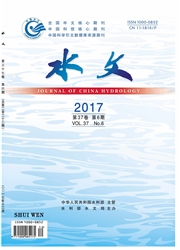

 中文摘要:
中文摘要:
三峡水库蓄水后,库区来流水质水量变化备受关注。基流分割在降雨-产流模型,水资源配置,点源和非点源污染解析中有重要意义。本文探讨了数字滤波原理,并以三峡库区香溪河流域为研究对象.利用数字滤波法对流域径流总量进行基流分割,分析滤波方程的参数和次数对基流分割结果的影响。结果表明滤波参数β越大,次数越多,分割得到的基流越小。同时将数字滤波法与平滑最小值法基流分割结果进行对比研究,以最小平滑值法为基准,结合香溪河流域特征,数字滤波法中滤波参数届取值0.925时.采用正-反-正三次滤波的基流分割结果最为恰当。
 英文摘要:
英文摘要:
After the impoundment of the Three Gorges Reservoir, the water quality and quantity of the inflow have been focused. Baseflow separation was widely applied in the rainfall-runoff model, water resources allocation, identification of point and non-point source pollutions. In Xiangxi River watershed of Three Gorges Reservoir area, digital filtering theory was employed to separate baseflow from river runoff to examine the effects of parameters and number of filtering equations on results of baseflow separation. The results indicate that the filtering parameter β and the number are inversely proportional to the separated baseflow. Using the minimum value method as a standard, the differences of the baseflow separation results of digital filtering with the results of the minimum smoothing were compared. According to the features of Xiangxi River watershed, the baseflow separation results that use positive-negative-positive three times filtering is most appropriate when β is set to 0.925.
 同期刊论文项目
同期刊论文项目
 同项目期刊论文
同项目期刊论文
 Prediction of chlorophyll a concentration using HJ-1 satellite imagery for Xiangxi Bay in Three Gorg
Prediction of chlorophyll a concentration using HJ-1 satellite imagery for Xiangxi Bay in Three Gorg Nutrient spatial pattern of the upstream, mainstream and tributaries of the Three Gorges Reservoir i
Nutrient spatial pattern of the upstream, mainstream and tributaries of the Three Gorges Reservoir i Responses of spring phytoplankton communities to their habitats in the Xiangxi Bay of Three Gorges R
Responses of spring phytoplankton communities to their habitats in the Xiangxi Bay of Three Gorges R A Coupled Model for predicting the Effect of the Three Gorges Reservoir on Downstream River-Connecte
A Coupled Model for predicting the Effect of the Three Gorges Reservoir on Downstream River-Connecte Predicting dissolved oxygen saturation downstream of Three Gorges Dam: A support vector machine mode
Predicting dissolved oxygen saturation downstream of Three Gorges Dam: A support vector machine mode Longitudinal hydrodynamic characteristics in reservoir tributary embayments and effects on algal blo
Longitudinal hydrodynamic characteristics in reservoir tributary embayments and effects on algal blo 期刊信息
期刊信息
